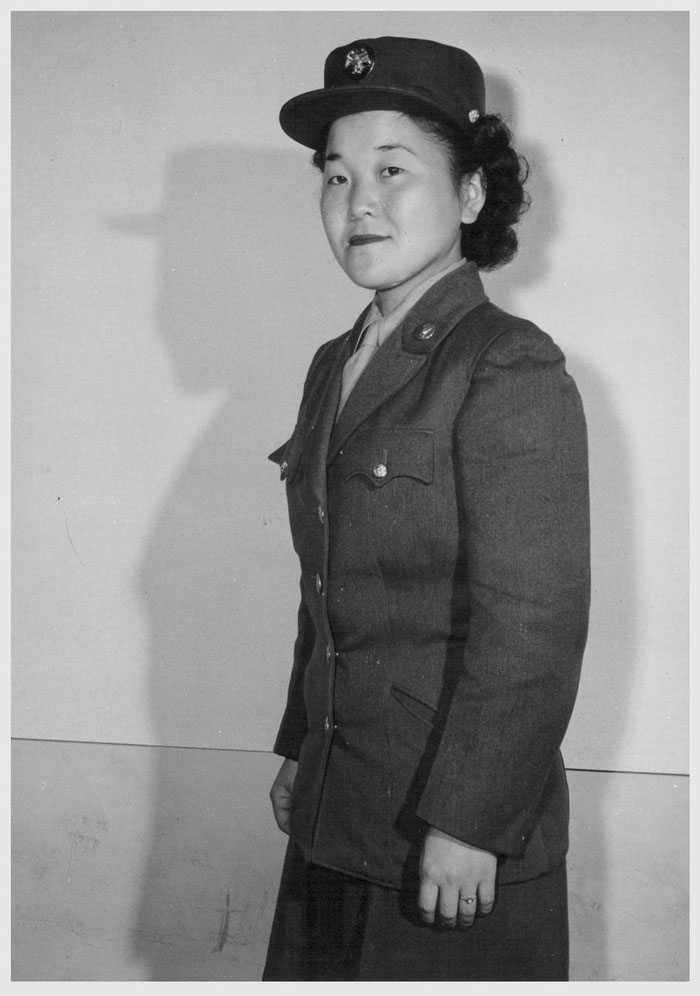
1943
Historical Timeline: 1943
Two Nisei soldiers in the 100th Infantry Battalion (Separate) repair an engine while training at Camp Shelby. Courtesy of the United States Army Signal Corps.
March 1, 1943
Sand Island detainment center on Oahu, Hawai’i, closes. Remaining detainees are transferred to a new center at Honouliuli, a gulch in central Oahu.
March 28, 1943
The Honolulu Chamber of Commerce sponsors a farewell ceremony at the Iolani Palace for 1,686 Nisei volunteers for the 442nd RCT.
April 13, 1943
The 442nd RCT arrives at Camp Shelby, Mississippi.
Lieutenant General John L. DeWitt protests the return of Japanese American soldiers and their families to their homes in his testimony before the House Naval Affairs Committee: “A Jap’s a Jap-it makes no difference if he is a citizen or not.” His testimony, released to the media, causes uproar in the Japanese American community.6
Dillon S. Myer. Courtesy of the War Relocation Authority.
June 21, 1943
The US Supreme Court rules in separate court cases against Gordon Hirabayashi and Minoru Yasui, who both challenged their military evacuation orders and were subsequently arrested and imprisoned.
The Court upholds the constitutionality of the curfew and detention of Japanese Americans.10
October 20, 1943
Platoon and company training for the 442nd RCT begins in Mississippi and continues for a month.
November 18, 1943
War Department reclassifies American citizens of Japanese ancestry for military service. It also permits the induction of Japanese aliens who volunteer and who meet certain requirements into the US Army.
Volturno River
Footnotes
- 1“Timeline,” 100th Infantry Battalion Veterans Education Center, accessed January 29, 2015, http://www.100thbattalion.org/learn/timeline/.
- 2“Loyalty: a questionnaire,” A More Perfect Union: Japanese Americans and the US Constitution, Smithsonian National Museum of American History, accessed on February 14, 2015, http://amhistory.si.edu/perfectunion/non-flash/loyalty_questionnaire.html.
- 3Norimitsu Onishi, “Tule Lake Journal: At Internment Camp, Exploring Choices of the Past,” The New York Times, July 8, 2012, accessed January 28, 2015, http://www.nytimes.com/2012/07/09/us/japanese-americans-seek-answers-at-internment-camp.html?pagewanted=all&_r=0.
- 4522nd Field Artillery Battalion, 442nd Regimental Combat Team, Fire for Effect (Honolulu, HI: Fisher Printing Co., 1998), p. 12.
- 5The Army Historical Foundation, “232nd Combat Engineer Company,” National Museum or the US Army, accessed February 8, 2015, https://armyhistory.org/232d-engineer-combat-company-nisei-442d-regimental-combat-team/.
- 6Although the exact phrase did not appear in the transcript of his testimony on April 13, 1943, the newspapers printed the quote and Gen. DeWitt himself would admit to Assistant Secretary of War John McCloy that he had said something “very similar to that.” See images of the transcript of the telephone conversation between DeWitt and McCloy and the extract of DeWitt’s testimony to the House Naval Affairs Committee by Alan Walker, “A Slap’s a Slap: General John L. DeWitt and Four Little Words,” Text Message: The work and discovery of processing and reference archivists on the job, November 22, 2013, National Archives, accessed on January 20, 2015, http://blogs.archives.gov/TextMessage/2013/11/22/a-slaps-a-slap-general-john-l-dewitt-and-four-little-words/.
- 7James C. McNaughton, Nisei Linguists: Japanese Americans in the Military Intelligence Service during World War II (Washington, DC: Department of the Army, 2006), p. 205.
- 8Ibid, pp. 166, 170.
- 9“The War Relocation Authority and the Incarceration of Japanese-Americans during WWII,” Harry S. Truman Library and Museum, accessed on February 3, 2015, http://www.trumanlibrary.org/whistlestop/study_collections/japanese_internment/1941.htm.
- 10Jay M. Brown, “When Military Necessity Overrules Constitutional Guarantees: The Treatment of Japanese Americans During World War II,” Yale-New Haven Teachers Institute, 2015, accessed on January 27, 2015, http://www.yale.edu/ynhti/curriculum/units/1982/3/82.03.01.x.html.
- 11Lyn Crost, Honor by Fire: Japanese Americans at War in Europe and the Pacific (Novato, CA: Presidio Press, 1997), p. 72.

















